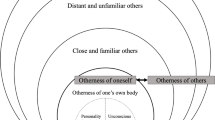Abstract
This article recounts the relationship of Wolfgang Stolper with Joseph A. Schumpeter, especially during Stolper's time as a student at the University of Bonn and Harvard University. The two derived their close relationship from the affinity between Schumpeter and Stolper's father, Gustaf Stolper.
Similar content being viewed by others
Notes
Wolfgang F. Stolper, Joseph Alois Schumpeter: The Public Life of a Private Man (Princeton University Press, 1994), p. xix.
Robert Loring Allen, Opening Doors (Transaction:1991), vol. I, p. 212. See also note 11, p. 159, and p. 142.
Loring Allen, vol. I, p. 204; Stolper, Joseph Alois Schumpeter, pp. 310–311; and Thomas K. McCraw, Prophet of Innovation (Harvard University Press: 2007), pp. 128–133.
Joseph Alois Schumpeter, p. 307.
“Joseph Alois Schumpeter – A Personal Memoir” (hereafter, Memoir), Challenge, January/February 1979, p. 68.
“Introductory Remarks” to a Schumpeter memorial in the Review of Economics and Statistics, vol. 33, No. 2 (May 1951), p. 96.
Toni Stolper, Ein Leben in Brennpunkten Unserer Zeit (A Life at the Focal Points of Our Time) (her biography mainly of Gustav Stolper) (Tuebingen: Rainer Wunderlich Verlag: 1960), pp. 326–327.
The friend was the son of Theodor Heuss, a colleague of Gustav Stolper in the German parliament at the time and president of the German Federal Republic between 1949 and 1959. Heuss died in 1963, after Toni Stolper’s biography was published. In private conversations, Wolf referred to Theodor Heuss as “Onkel Theodor.”
His troubles are mentioned briefly in a letter from Gustav Stolper to Schumpeter dated November 2, 1933, found in the Harvard University archives in a collection of Schumpeter - Gustav Stolper correspondence.
Gustav Stolper apparently established rich connections inter alia with the New York banking community. When the possibility of nuclear fission was discovered in Berlin, emigre physicists Leo Szilard and Eugene Wigner saw that a powerful bomb might be built through the fission of uranium. Frustrated over their inability to induce formal research programs in military R&D quarters, they contacted Gustav Stolper, who in 1939 put them in contact with Lehman Brothers vice president Alexander Sachs. A letter written by Szilard and Wigner and signed by Albert Einstein urging governmental action on the uranium problem was hand-carried in October 1939 by Sachs to his friend Franklin D. Roosevelt. After having the letter’s contents explained by Sachs, Roosevelt allegedly said to Sachs, “Alex, what you are after is to see that the Nazis don’t blow us up.” He then passed the letter on to his secretary Edwin “Pa” Watson and stated, “Pa, this requires action.” Research that led to the Manhattan Project was thereupon set in motion. See R. G. Hewlett and O. E. Anderson, A History of the United States Atomic Energy Commission, vol. I (Pennsylvania State University Press, 1962), pp. 16–17; and Richard Rhodes, The Making of the Atomic Bomb (Simon & Schuster: 1986), pp. 303–308.
Stolper, “Memoir,” Challenge, January/February 1979, p. 68.
See idem, p. 69; and Loring Allen, vol. 2, p. 32.
They married in New York City during August 1937. In the Harvard archives is a telegram from Gustav Stolper to Schumpeter offering Stolper’s Rye, New York, house for the honeymoon. Whether the invitation was accepted is unknown.
“British Monetary Policy and the Housing Boom,” Quarterly Journal of Economics, vol. 56 (November 1941), Part II.
There is also no indication of a Schumpeter role in Stolper’s most famous publication, with Paul Samuelson, “Protection and Real Wages,” Review of Economic Studies, November 1941, pp. 58–73.
Challenge, p. 69.
The co-authors were Gottfried Haberler, Seymour Harris, Wassily Leontief, and Edward H. Chamberlin. It is reproduced in The Review of Economics and Statistics, vol. 33 (May 1951), pp. 89–90.
Idem, pp. 170–177.
Author information
Authors and Affiliations
Corresponding author
Rights and permissions
About this article
Cite this article
Scherer, F.M. Joseph Schumpeter and Wolfgang Stolper. J Evol Econ 25, 223–227 (2015). https://doi.org/10.1007/s00191-014-0366-4
Published:
Issue Date:
DOI: https://doi.org/10.1007/s00191-014-0366-4




